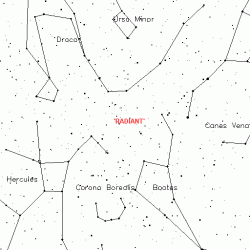Its radiant belongs to an extinct constellation once known as Quadran Muralis, but any meteors will seem to come from the general direction of bright Arcturus and Boötes.

|
| ©Unknown |
This is a very narrow stream, which may have once belonged to a portion of the Aquarids, but recent scientific data points to a what may have been a cosmic collision.
According the most recent data, the Quandrantid meteors may have been formed about five centuries ago when a near-Earth asteroid named 2003 EH1 and a comet smashed into one another. Historic records from ancient China put comet C/1490 Y1 in the path of probability. As Jupiter's gravity continues to perturb the stream, another 400 years may mean this shower will become as extinct as the constellation for which it was once known... But NASA scientists and astronomers are taking to the skies to study the event.
A Gulfstream V aircraft will fly scientists and their instruments for 10 continuous hours over the Arctic to observe and record meteor activity. From above the Earth, the stream can be studied without light pollution and clouds to determine when the activity peaks and how the stream is dispersed. "We will fly to the North Pole and back to compensate for Earth's rotation and to keep the stream in view throughout the flight," said Peter Jenniskens, a principal investigator at NASA's Ames Research Center.
According to NASA, scientists believe this could be the most brilliant meteor shower in 2008 with over 100 visible meteors per hour at its peak. Best viewing times with the highest meteor rates are expected to be in either the late evening of Jan. 3 over Europe and western Asia or the early morning of Jan. 4 over the eastern United States. For the USA: 6pm - 2am (Pacific Time) on Jan. 3 and 4, 2008. For Northern Europe: 2am - 10am (London) on Jan. 4, 2008. For Northern Asia: 11am - 7pm (Tokyo) on Jan. 4, 2008. For almost of us, this means bundling up against the cold and battling the remnants of the waning Moon... But the sight of even one "shooting star" can make the trip worthwhile!
Will the Quadrantid Meteor Shower live up to its expectations? No one knows for sure... But we'll be watching!



Reader Comments
to our Newsletter